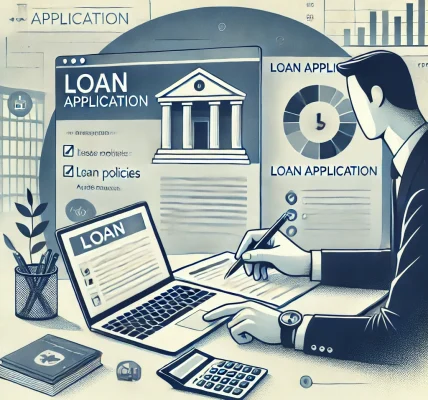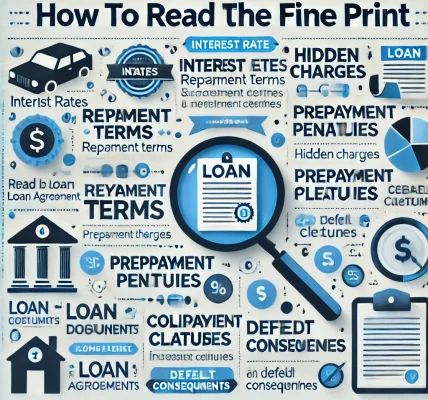Introduction
When taking out a loan, one of the most important decisions you will face is choosing between a fixed interest rate and a floating interest rate. Your choice can significantly impact your monthly payments, the total cost of the loan, and your overall financial strategy.
In this article, we will explore the differences between fixed and floating interest rates, their advantages and disadvantages, and which option may be better suited for different types of borrowers.
Disclaimer: This article is for informational purposes only and should not be considered financial or legal advice. Loan terms and policies vary by lender and country. Always consult with a financial expert before making borrowing decisions.
What is a Fixed Interest Rate?
A fixed interest rate remains the same throughout the loan tenure. This means that the monthly payments remain consistent, making budgeting easier. Fixed-rate loans are commonly used for mortgages, personal loans, auto loans, and student loans.
Key Features of Fixed Interest Rates:
✔ The interest rate does not change over the life of the loan. ✔ Monthly payments remain constant. ✔ Suitable for borrowers who prefer stability and predictability. ✔ Typically higher than initial floating rates but avoids future rate hikes.
Advantages of Fixed Interest Rates:
✅ Predictability: Since the interest rate remains unchanged, you know exactly how much to pay each month, making financial planning easier. ✅ Protection from Market Fluctuations: Even if market interest rates rise, your loan payments remain unaffected. ✅ Easier Budgeting: Fixed payments ensure that you won’t face sudden increases in loan costs.
Disadvantages of Fixed Interest Rates:
❌ Higher Initial Rate: Fixed interest rates are usually higher than the starting rates of floating loans. ❌ Less Flexibility: You may miss out on savings if market rates decrease. ❌ Prepayment Penalties: Some lenders charge higher penalties for early repayment of fixed-rate loans.
What is a Floating Interest Rate?
A floating (or variable) interest rate fluctuates based on market conditions. The rate is usually tied to a benchmark rate, such as the prime rate, LIBOR, or a central bank’s policy rate. This means that your loan payments may increase or decrease over time.
Key Features of Floating Interest Rates:
✔ The interest rate changes periodically based on market trends. ✔ Monthly payments may vary over the loan term. ✔ Ideal for borrowers who can tolerate risk and want potential savings. ✔ Generally starts lower than fixed rates but can increase over time.
Advantages of Floating Interest Rates:
✅ Lower Initial Rates: Floating rates are usually lower than fixed rates at the beginning of the loan term. ✅ Potential for Savings: If market interest rates decline, you can benefit from lower loan payments. ✅ Good for Short-Term Loans: If you plan to repay the loan quickly, a floating rate may offer cost savings.
Disadvantages of Floating Interest Rates:
❌ Uncertainty: Monthly payments can increase unexpectedly, making budgeting difficult. ❌ Higher Risk: If interest rates rise significantly, your loan becomes more expensive. ❌ Difficult Financial Planning: Borrowers may struggle with sudden increases in loan repayment amounts.
Comparison: Fixed vs. Floating Interest Rates
| Feature | Fixed Interest Rate | Floating Interest Rate |
|---|---|---|
| Stability | Highly stable | Unpredictable, fluctuates with the market |
| Initial Rate | Usually higher | Typically lower |
| Monthly Payment | Consistent throughout the loan term | Changes based on market rates |
| Best For | Long-term borrowers who prefer stability | Risk-tolerant borrowers looking for savings |
| Market Sensitivity | Not affected by interest rate changes | Directly affected by market fluctuations |
| Early Repayment | May have penalties | Generally lower penalties |
Which One is Better?
Choose a Fixed Interest Rate If:
✔ You prefer stability and predictable monthly payments. ✔ You are taking a long-term loan, such as a 20- or 30-year mortgage. ✔ You expect market interest rates to rise in the future. ✔ You have a tight budget and cannot afford fluctuating payments.
Choose a Floating Interest Rate If:
✔ You are comfortable with some risk and market fluctuations. ✔ You are taking a short-term loan and want to save on interest payments. ✔ You expect market interest rates to decline in the future. ✔ You have sufficient financial flexibility to manage potential rate increases.
Examples of Loans with Fixed and Floating Rates
Common Loans with Fixed Interest Rates:
📌 Home Loans: Fixed-rate mortgages provide long-term stability. 📌 Auto Loans: Car loans often have fixed rates for predictable payments. 📌 Personal Loans: Fixed-rate personal loans help borrowers manage debt efficiently.
Common Loans with Floating Interest Rates:
📌 Home Loans (Adjustable-Rate Mortgages – ARMs): The interest rate is fixed for an initial period and then fluctuates. 📌 Student Loans: Some student loans have variable rates that adjust periodically. 📌 Business Loans: Many business loans use floating rates based on market trends.
Strategies for Managing Interest Rate Risks
- If You Choose a Fixed Rate:
- Make sure you secure a competitive interest rate by comparing lenders.
- Consider refinancing if market rates drop significantly.
- Be aware of prepayment penalties before paying off the loan early.
- If You Choose a Floating Rate:
- Plan for possible interest rate hikes by maintaining a financial buffer.
- Check if the loan allows you to switch to a fixed rate later.
- Keep track of market trends to anticipate changes in your loan payments.
Conclusion
Both fixed and floating interest rates have their own advantages and drawbacks. The best choice depends on your financial stability, risk tolerance, and market expectations.
- If you prioritize stability and long-term financial planning, a fixed interest rate is ideal.
- If you want to take advantage of potential interest rate reductions and can handle risk, a floating interest rate may be a better choice.
Before making a decision, always compare multiple lenders, review terms carefully, and consider your future financial situation. Consulting with a financial expert can also help ensure that you make the best choice for your needs.
Disclaimer: This article is for educational purposes only and does not constitute financial advice. Loan terms and eligibility criteria vary by lender and country. Always review the terms and conditions before making a borrowing decision.



